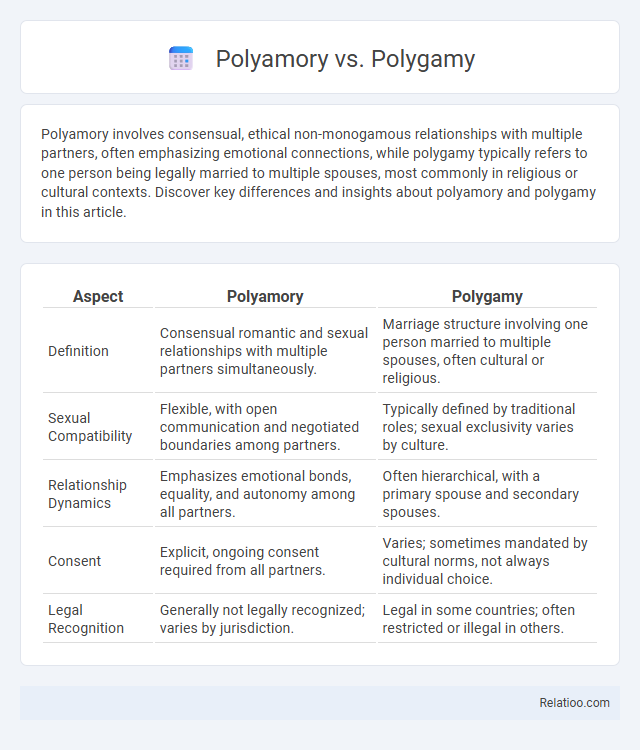Polyamory involves consensual, ethical non-monogamous relationships with multiple partners, often emphasizing emotional connections, while polygamy typically refers to one person being legally married to multiple spouses, most commonly in religious or cultural contexts. Discover key differences and insights about polyamory and polygamy in this article.
Table of Comparison
| Aspect | Polyamory | Polygamy |
|---|---|---|
| Definition | Consensual romantic and sexual relationships with multiple partners simultaneously. | Marriage structure involving one person married to multiple spouses, often cultural or religious. |
| Sexual Compatibility | Flexible, with open communication and negotiated boundaries among partners. | Typically defined by traditional roles; sexual exclusivity varies by culture. |
| Relationship Dynamics | Emphasizes emotional bonds, equality, and autonomy among all partners. | Often hierarchical, with a primary spouse and secondary spouses. |
| Consent | Explicit, ongoing consent required from all partners. | Varies; sometimes mandated by cultural norms, not always individual choice. |
| Legal Recognition | Generally not legally recognized; varies by jurisdiction. | Legal in some countries; often restricted or illegal in others. |
Understanding Polyamory and Polygamy: Key Definitions
Polyamory involves consensual, ethical relationships with multiple partners simultaneously, emphasizing emotional connections and transparency among all individuals. Polygamy refers to a marital practice where one person is legally married to multiple spouses, commonly seen in cultural or religious contexts, often without the requirement of emotional involvement with all partners. Understanding these key definitions clarifies the fundamental differences between relationship structures centered on consent and emotional bonds versus legal and cultural marital arrangements.
Historical Contexts: The Origins of Polyamory and Polygamy
Polyamory and polygamy both have distinct historical origins rooted in different cultural and social practices. Polygamy, often practiced in ancient civilizations and religious traditions, typically involves one individual having multiple spouses and is legally recognized in certain societies. Polyamory, emerging more prominently in the late 20th century, emphasizes consensual and ethical non-monogamous relationships without legal or religious binding, reflecting evolving views on love and partnership that may resonate with your relationship values.
Core Differences Between Polyamory and Polygamy
Polyamory involves consensual romantic relationships with multiple partners simultaneously, emphasizing emotional connections and transparency among all parties. Polygamy typically refers to a marital structure where one person is legally married to multiple spouses, often rooted in cultural or religious traditions. Understanding these core differences helps you navigate relationship choices with clarity about personal values and legal implications.
Legal Status: Polyamory vs Polygamy Worldwide
Polyamory, characterized by consensual non-monogamous relationships, is not legally recognized as marriage in most countries, focusing instead on personal relationship agreements, while polygamy, typically involving one person married to multiple spouses, is legally recognized or tolerated in some regions, particularly in parts of Africa, the Middle East, and Asia. The legal status of polygamy varies widely, with many Western countries prohibiting it under bigamy laws, contrasting with several nations where it holds cultural and religious legitimacy. Your understanding of these distinctions impacts legal rights, inheritance, and social acceptance, emphasizing the importance of knowing local laws when navigating these relationship styles.
Cultural Perspectives and Social Acceptance
Polyamory, polygamy, and polyandry differ significantly in cultural perspectives and social acceptance worldwide. Polygamy, often associated with religious or traditional practices, is legally recognized and socially accepted in certain regions, particularly in parts of Africa and the Middle East. Polyamory, emphasizing consensual and ethical non-monogamy without legal marriage ties, gains growing social acceptance in Western societies but remains marginalized in many cultures.
Relationship Dynamics and Structures
Polyamory involves consensual, ethical non-monogamous relationships where individuals maintain multiple romantic or intimate partnerships with transparency and mutual agreement. Polygamy is a culturally or religiously sanctioned form of marriage involving one person married to multiple spouses, typically with legal or societal recognition. Polyfidelity, a subset of polyamory, emphasizes closed groups where all members are equally committed, contrasting with the often more fluid relationship boundaries in broader polyamorous arrangements.
Challenges and Misconceptions
Challenges in polyamory often involve navigating complex emotional dynamics and communication among multiple partners, while polygamy faces legal restrictions and societal stigma in many countries. Misconceptions about polyamory include the belief that it lacks commitment or is simply about promiscuity, whereas polygamy is frequently misunderstood as always rooted in patriarchal control. Understanding these distinctions is crucial for respecting diverse relationship structures and addressing biases effectively.
Ethical Considerations in Non-Monogamous Relationships
Ethical considerations in polyamory, polygamy, and polyandry center on informed consent, transparency, and mutual respect among all partners. You must prioritize open communication and honesty to navigate the complexities of non-monogamous relationships ethically. Each relationship model demands commitment to equality and emotional well-being to maintain trust and prevent harm.
Polyamory and Polygamy in Modern Media
Polyamory and polygamy often appear in modern media, highlighting distinct relationship structures: polyamory involves consensual, ethical non-monogamy with multiple romantic partners, while polygamy typically refers to marriage to multiple spouses, often with religious or cultural implications. You will find polyamory portrayed more frequently in TV shows and films emphasizing communication, emotional complexity, and non-traditional family dynamics, whereas polygamy is commonly depicted with a focus on legal, societal, and sometimes controversial aspects. The representation of both relationship models in entertainment reflects evolving conversations about love, commitment, and social norms in contemporary society.
Choosing What’s Right: Navigating Relationship Choices
Choosing between polyamory, polygamy, and monogamy involves understanding the distinct structures and values each relationship style embodies. Polyamory emphasizes consensual, ethical non-monogamy with multiple emotional connections, while polygamy is often culturally or religiously rooted, involving one person married to multiple spouses. Making an informed decision requires reflecting on personal beliefs, communication preferences, and lifestyle compatibility to navigate relationship choices that foster trust and fulfillment.

Infographic: Polyamory vs Polygamy
 relatioo.com
relatioo.com